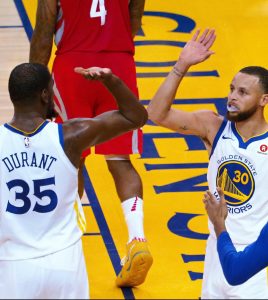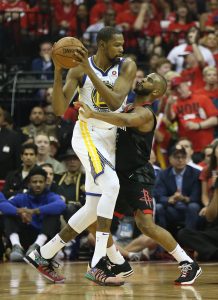Peak Stephen Curry came to play during Game 3 of the Western Conference Finals. The two-time MVP hit all seven of his shots from the field during a third quarter that essentially put the game out of reach.
He finished with a game-high 35 points, delivering a series of highlights for the home crowd and silencing the doubters who dubbed him as a liability.
Curry’s game came on the heels of two top performances by Kevin Durant where the former No. 2 overall pick scored 37 and 38 points in Game 1 and 2, respectively. Durant didn’t disappoint in Game 3, scoring 25 points, a total that nearly doubled every player in the game with the exception of Curry and James Harden.

Many were outraged when Durant elected to join Golden State during the summer of 2016, citing an unnatural balance in the basketball realm. However, it was an outcome made possible by a collection of events. Let’s examine how No. 35 was able to make his way to Northern California.
The Max Contract
The year is 1997 and Kevin Garnett is the league’s next bright, young star. At 22-years-old, his rookie contract is approaching its end and he signs a six-year, $126MM contract with Wolves during the 1997/98 season. It’s the biggest contract in the history of the league and NBA owners are fearful of what doling out those kinds of deals could mean for the future of their franchises.
The angst was partially to blame for the lockout during the 1998/99 season and the maximum salary deal was born as a result of heavy negotiations between owners and players. The new structure put a ceiling on what players could earn.
Imagine a world where there is no max salary and top players can earn what the market dictates. Someone like Durant could theoretically command 50% of the salary cap, maybe more. Instead, with the max deal limiting players’ earnings, shunning the most lucrative offer in favor of one with a better on-court situation becomes less of a sacrifice and teaming up with other superstars becomes more appealing.
The latest CBA gave teams a great tool in the Designated Players Extension, a deal designed to give organizations an unquestioned financial advantage in retaining their own players. This vehicle wasn’t yet available when Oklahoma City fought to keep Durant and some believe the new extension option came as a result of his departure.
Curry’s At-The-Time Below Market Deal
The Warriors signed the former No. 7 overall pick to a $44MM extension back in 2012 and he had one season left on that contract when Durant hit free agency in 2016. Curry had just come off back-to-back MVP seasons, one in which he was the only player in the history of the league to unanimously win the MVP award. Had there not been concern over Curry’s ankle, perhaps he signs a rookie extension similar to James Harden‘s $80MM deal back in 2012 and four years later, the Warriors might have needed to make real sacrifices in order to bring Durant in, assuming he comes at all under a new, slightly less favorable arrangement.
The NBA’s Salary Cap Spike
Another factor was the league’s massive media rights deal that caused a cap spike like we’ve never seen before. The 2016/17 salary cap increased by over $24MM from the 2015/16 figures. Prior to that spike, the year-to-year change never surpassed $8MM.
Leading up to the summer of 2016, the NBA and the NBA Players Association discussed a cap-smoothing proposal, as the owners foresaw some issues with the gargantuan spike. The 2016 free agent class would be the overwhelming beneficiaries from the media rights deal under the CBA’s framework and the NBA wanted to make an adjustment to the legal-binding agreement. The proposed plan would artificially lower the salary cap and the difference between the actual increase in basketball-related income and the proposed, lowered artificial salary cap would be evenly distributed to all the players in the league.

The altered agreement would have meant a much lower salary cap for teams heading into the 2016 offseason while providing the players with the same 51% of the revenue they were entitled to as part of the 2011 CBA. However, the NBA Player’s Union rejected the deal. (Fun fact: Chris Paul, a man who’s now trying to bringing down Golden State’s powerhouse, was the President of the NBPA at the time and remains in the position today).
July 2016 came without a solution for the spike and teams couldn’t spend the money fast enough. Over $2 billion worth of contracts were handed out in the first 48 hours of free agency. At the time, FiveThirtyEight estimated that the average contract in 2016 was overvalued by $4,4MM per year. Two years later with players like Timofey Mozgov ($16MM/year) and Joakim Noah ($18MM/year) getting paid handsomely, it’s arguable that the statistical publication was conservative on its estimates.
No one’s arguing that the Warriors mismanaged their financials by signing Durant to the two-year pact worth roughly $53MM. Golden State is nearly unstoppable when Durant and Curry are both on their games and the team has gone 26-4 in the postseason since Durant brought his talents to the bay area.
Durant’s signing will forever be known as a move that altered the league, one that was made possible by a perfect storm. You’ll hear criticism and complaint from many parties, but it was a group effort that built the bridge allowing Durant to waltz over to Golden State. In addition to the Warriors, the league’s owners and players are among those responsible for his ability to take that path.
Photos Courtesy of USA TODAY Sports Images

